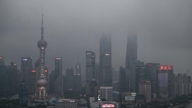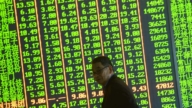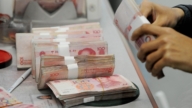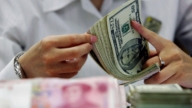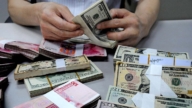【新唐人2014年05月31日讯】日前,中国十大银行公布,截至去年底的逾期贷款达到5,880亿元人民币,创下2009年以来最高水平。那么,这些贷款都给了谁?大量的不良贷款会给国家与民众带来什么后果?我们来看看。
据美国《彭博新闻社》报导,截至2013年底,中国十大银行的逾期贷款达到5,880亿元,同比大增21%,这是至少2009年来的最高水平。而且,银行的“逾期贷款”比“不良贷款”高出31%,也创下5年来最大差距。
截至今年一季度末,商业银行“不良贷款”余额达6,461亿元,较年初增加541亿元,达到了过去3年以来的最高值。交通银行预测,如果经济明显下滑,或者房地产价格危及相关行业,银行坏账率可能会升到2009年来的新高。这将给银行带来更多的损失,在中国经济放缓的大背景下,借款人的日子将更难过。
美国金融分析、信用评级机构“标准普尔”认为,银行的“逾期贷款”是资产质量恶化的领先指标。
中国金融智库研究员巩胜利:“几大国有银行占了全国货币的80%以上,这个银行一个出问题,就会牵涉到全国的经济运行。”
大陆经济学者邓先生:“偷偷的变相的发货币(解决),比较严重的情景就是通胀和通缩同时发生。通货紧缩,就是有钱也买不到货,没有人去生产,因为没有资金,生产企业的资金周转都非常困难﹔通货膨胀的问题是什么,所有的东西价格太高买不起。”
90年代末,中共通过剥离四大国有银行的不良贷款,成立了资产管理公司来处理这些烂账,同时注资和斥资超过6,500亿美元,对银行实施了救助。
那么这些钱到底去了哪里?
巩胜利:“首先贷给了国有企业,比如重庆的企业遇到了灾难,国资委发动了所有的国有银行,结果成交了300亿,一下子就缓解了重庆的资金链的断裂。非洲的援助项目比原先支付多了2/3。”
4月底,中国外汇管理局公布的数据显示,“2013年中国对外投资”亏损599亿美元,比上一年扩大了70%。
中国银监会的数据显示,中资银行过去五年新增资产89万亿元人民币,几乎相当于美国银行业的整体规模,而中国银行业盈利占了全球银行业的30%,国务院发展研究中心研究员吴庆指出,中国的银行躺着都能赚钱。
巩胜利:“因为中国实行的很多政策都是双轨制,人民银行是发行货币的,但是人民银行不经营货币,货币拿给了商业银行来运行,那商业银行运行的越多,它肯定获得的利润就越高,国家富了,老百姓依然贫穷,与银行的利润过高,有很大的关系。”
不过,根据中国“国泰君安证券”(Guotai Junan Securities)4月份的报告,中国16支上市银行股的平均估值,为今年预估净资产的0.77倍,由此反映的不良贷款率达到5.8%。在香港市场上,中国第一大银行——工商银行今年下挫5%,第二大的建设银行下跌3%,第三大行农业银行下挫9.7%。
中国金融智库研究员巩胜利指出,中国的国有银行之所以能承受巨大的资金黑洞,除了政府的支持外,中国百姓,是它最大支柱。
交易所申报文件显示,截至12月31号,招商银行、浦发银行、中信银行、兴业银行和民生银行,这些民营银行的逾期贷款总额为1,330亿元人民币,比公布的不良债务高出77%。
巩胜利:“五大商业银行占的货币总额超过了80%,这些垄断性的银行,它的市场这么大,自然就赚了,小的银行就没有市场,没有流动,更没有办法生存。比如说,中国工商银行是全球的头号了,没有从全国老百姓那儿获得的利益,它怎么会长大呢。”
巩胜利指出,国有银行支持的国有企业,扼杀了中国的市场。
采访编辑/刘惠 后制/舒灿
What Does an Overdue Loan of up to 600 billion RMB Mean to Chinese People?
In recent days, China´s 10 banks announced that at the end
of last year that overdue loans reached 588 billion RMB,
a record high since 2009.
So who received these loans?
How will a large amount of past due loans
impact the country and the people?
Let´s watch the program.
According to U.S. based Bloomberg News Agency,
at the end of 2013, the overdue loans of 10 Chinese banks
had reached 588 billion RMB, an increase of 21 percent
from last year and a new record since 2009.
In addition, the overdue loans are 31 percent higher
than bad loans, the largest gap in past five years.
The bad loans of commercial banks increased by 54.1 billion
during the first quarter of 2014, reaching 646.1 billion,
a record high over the past 3 years.
Bank of Communications forecasts that if the economy
significantly slows down or falling property prices
impact the relevant industries, the rate of bad accounts
will be the highest since 2009.
This will lead to more bank losses.
Given the slowing economy, lenders will suffer more.
Standard & Poor’s say the overdue loans are a guiding
precursor signifying the deterioration of assets.
China Financial Think Tank researcher Mr Gong Shengli:
“A few major state-owned banks own 80 percent
of the country´s monetary aggregates.
Once such banks have problems, the national economy
operation will be impacted.”
Mainland economic scholar Mr Deng:
“Secretly issuing currency is (to solve the issue).
But the relatively severe scenario is the concurrence
of inflation and deflation.
Deflation means that it is difficult to buy something
even with money in hand because there is no production
as a result of funds shortage and even the lack
of manufacturers´ revolving funds.
The issue with inflation is that prices are
so high they are unaffordable.”
At the end of the 1990s, the Chinese Communist Party (CCP)
disposed of the bad loans of four state-owned banks
via assets management companies that were specifically
developed for that purpose.
Meanwhile more than 650 Billion U.S. Dollars
were injected into them.
So where does such money go?
Gong Shengli: “First, the loans are lent
to state-owned enterprises.
For example, if enterprises in Chongqing meet with disaster,
the State-Owned Assets Supervision and Administration
Commission mobilize all state-owned banks
to provide funding.
As a result, these banks lent 30 billion RMB to relieve
the broken capital chain of Chongqing enterprises.
The aid funds to Africa are also two thirds
more than the scheduled funds.”
At the end of April, according to the data published
by China´s Foreign Currency Administration Bureau,
“2013 China´s Outbound Investment” lost 59.9 billion
U.S. Dollars, 70 percent more than this time last year.
According to China Bank Regulatory Commission data,
the increased assets of Chinese banks
over the past five years reached 89 trillion RMB,
equal to the assets scale of the entire U.S. bank industry.
Bank of China profits accounts for 30 percent
of the global bank industry.
Wu Qing, researcher at the State Development
Research Center, says Chinese banks can make money
even by doing nothing.
Gong Shengli: “Many Chinese policies
are binary systems.
Peopl´s Bank is only responsible for issuing currency
and they don´t do business with the currency.
All currency is operated by commercial banks.
So if the commercial banks have more money
to do business, then they surely obtain more profits.
The state can be richer, but the people are still poor.
Their poverty is related to the excessive profits of banks.”
However, according to China Guotai Junan Securities´
April report, the average valuation
of 16 publicly listed Chinese banks is 0.77 times
as much as the forecast net assets this year.
This shows that the bad loan ratio is 5.8 percent.
On the Hong Kong stock exchange, share prices
of the largest Chinese bank—Industrial and Commercial
Bank of China— are down 5 percent, while shares
of the second largest bank—Construction Bank of China—
fell by 3 percent and shares of the third largest bank—
Agriculture Bank of China—dropped 9.7 percent.
Gong Shengli commented that the reason
Chinese state-owned banks can sustain such a huge deficit
is mainly due to the support of Chinese people
and the government.
According to the declarations of the stock exchange,
up until Dec. 31, private banks, including China Merchants
Bank, Shanghai Pudong Development Bank,
China CITIC Bank, the National Commercial Bank
and China Minsheng Bank had overdue loans
of 133 billion RMB, 77 percent higher than their bad debts.
Gong Shengli: “The top five major commercial banks
have a total of currency amount of more than 80 percent
of all currency.
These monopolised banks have such a vast market
and it is natural to make money.
But small banks have no market and liquidity,
hence their survival is difficult.
For example, Industry and Commerce Bank of China
is the number one bank in the world.
How could it have grown so huge without having obtained
benefits from the people across China?”
Gong Shengli says the state-owned banks’ support of state-
owned enterprises also suffocates the Chinese market.
Interview & Edit/Liu Hui Post-Production/Shu Can


